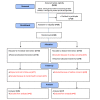Heart Rate Variability Biofeedback to Treat Anxiety in Young People With Autism Spectrum Disorder: Findings From a Home-Based Pilot Study
- PMID: 36018712
- PMCID: PMC9463620
- DOI: 10.2196/37994
Heart Rate Variability Biofeedback to Treat Anxiety in Young People With Autism Spectrum Disorder: Findings From a Home-Based Pilot Study
Abstract
Background: People with autism spectrum disorder (ASD) frequently experience high levels of anxiety. Despite this, many clinical settings do not provide specialist ASD mental health services, and demand for professional support frequently outstrips supply. Across many sectors of health, investigators have explored digital health solutions to mitigate demand and extend the reach of professional practice beyond traditional clinical settings.
Objective: This critical appraisal and pilot feasibility study examines heart rate variability (HRV) biofeedback as an approach to help young people with ASD to manage anxiety symptoms outside of formal settings. The aim is to explore the use of portable biofeedback devices to manage anxiety, while also highlighting the risks and benefits of this approach with this population.
Methods: We assessed the feasibility of using home-based HRV biofeedback for self-management of anxiety in young people with ASD. We adopted coproduction, involving people with ASD, to facilitate development of the study design. Next, a separate pilot with 20 participants with ASD (n=16, 80% male participants and n=4, 20% female participants, aged 13-24 years; IQ>70) assessed adoption and acceptability of HRV biofeedback devices for home use over a 12-week period. Data were collected from both carers and participants through questionnaires and interviews; participants also provided single-lead electrocardiogram recordings as well as daily reports through smartphone on adoption and use of their device.
Results: Pre-post participant questionnaires indicated a significant reduction in anxiety in children (t6=2.55; P=.04; Cohen d=0.99) as well as adults (t7=3.95; P=.006; Cohen d=0.54). Participant age was significantly negatively correlated with all HRV variables at baseline, namely high-frequency heart rate variability (HF-HRV: P=.02), the root mean square of successive differences in normal heartbeat contractions (RMSSD: P=.02) and the variability of normal-to-normal interbeat intervals (SDNN: P=.04). At follow-up, only SDNN was significantly negatively correlated with age (P=.05). Levels of ASD symptoms were positively correlated with heart rate both before (P=.04) and after the intervention (P=.01). The majority (311/474, 65.6%) of reports from participants indicated that the devices helped when used. Difficulties with the use of some devices and problems with home testing of HRV were noted. These initial findings are discussed within the context of the strengths and challenges of remotely delivering a biofeedback intervention for people with ASD.
Conclusions: HRV biofeedback devices have shown promise in this pilot study. There is now a need for larger evaluation of biofeedback to determine which delivery methods achieve the greatest effect for people with ASD.
Trial registration: ClinicalTrials.gov NCT04955093; https://clinicaltrials.gov/ct2/show/NCT04955093.
Keywords: anxiety; autism; biofeedback; mobile phone; remote intervention.
©Helen Coulter, Mark Donnelly, John Mallett, W George Kernohan. Originally published in JMIR Formative Research (https://formative.jmir.org), 26.08.2022.
Conflict of interest statement
Conflicts of Interest: None declared.
Figures


Similar articles
-
Heart rate variability biofeedback to reduce anxiety in autism spectrum disorder - a mini review.Front Psychiatry. 2024 Jun 13;15:1409173. doi: 10.3389/fpsyt.2024.1409173. eCollection 2024. Front Psychiatry. 2024. PMID: 38938467 Free PMC article. Review.
-
Remote Short Sessions of Heart Rate Variability Biofeedback Monitored With Wearable Technology: Open-Label Prospective Feasibility Study.JMIR Ment Health. 2024 Apr 25;11:e55552. doi: 10.2196/55552. JMIR Ment Health. 2024. PMID: 38663011 Free PMC article.
-
Effects of Heart Rate Variability (HRV) Biofeedback for Women Undergoing First-time In Vitro Fertilization and Embryo Transfer.Altern Ther Health Med. 2023 Mar;29(2):162-167. Altern Ther Health Med. 2023. PMID: 36455143 Clinical Trial.
-
Reduced heart rate variability in adults with autism spectrum disorder.Autism Res. 2019 Jun;12(6):922-930. doi: 10.1002/aur.2104. Epub 2019 Apr 10. Autism Res. 2019. PMID: 30972967
-
A Practical Guide to Resonance Frequency Assessment for Heart Rate Variability Biofeedback.Front Neurosci. 2020 Oct 8;14:570400. doi: 10.3389/fnins.2020.570400. eCollection 2020. Front Neurosci. 2020. PMID: 33117119 Free PMC article. Review.
Cited by
-
Quality-of-life measurement in randomised controlled trials of mental health interventions for autistic adults: A systematic review.Autism. 2025 Mar;29(3):579-595. doi: 10.1177/13623613241287586. Epub 2024 Oct 22. Autism. 2025. PMID: 39434651 Free PMC article.
-
The Physiological and Clinical-Behavioral Effects of Heart Rate Variability Biofeedback in Adolescents with Autism: A Pilot Randomized Controlled Trial.Appl Psychophysiol Biofeedback. 2024 Sep;49(3):419-438. doi: 10.1007/s10484-024-09638-1. Epub 2024 Mar 15. Appl Psychophysiol Biofeedback. 2024. PMID: 38491260 Clinical Trial.
-
Cardiac Autonomic Measures Predict Clinician-Rated Anxiety and Behavioral Response to Propranolol in Autistic Children and Young Adults.J Pers Med. 2025 Jul 3;15(7):286. doi: 10.3390/jpm15070286. J Pers Med. 2025. PMID: 40710403 Free PMC article.
-
Heart rate variability biofeedback to reduce anxiety in autism spectrum disorder - a mini review.Front Psychiatry. 2024 Jun 13;15:1409173. doi: 10.3389/fpsyt.2024.1409173. eCollection 2024. Front Psychiatry. 2024. PMID: 38938467 Free PMC article. Review.
-
Wearable Solutions Using Physiological Signals for Stress Monitoring on Individuals with Autism Spectrum Disorder (ASD): A Systematic Literature Review.Sensors (Basel). 2024 Dec 20;24(24):8137. doi: 10.3390/s24248137. Sensors (Basel). 2024. PMID: 39771872 Free PMC article.
References
-
- What is Autism? National Autistic Society. [2022-04-01]. https://www.autism.org.uk/advice-and-guidance/what-is-autism .
-
- Kanner L. Autistic disturbance of affective contact. The Embryo Project Encyclopedia. 1943. [2014-01-12]. https://embryo.asu.edu/pages/autistic-disturbances-affective-contact-194... .
-
- The Diagnostic and Statistical Manual of Mental Disorders, Fifth Edition. Virginia, United States: American Psychiatric Association; 2013.
-
- Baird G, Simonoff E, Pickles A, Chandler S, Loucas T, Meldrum D, Charman T. Prevalence of disorders of the autism spectrum in a population cohort of children in South Thames: the Special Needs and Autism Project (SNAP) Lancet. 2006 Jul;368(9531):210–5. doi: 10.1016/s0140-6736(06)69041-7. - DOI - PubMed
Associated data
LinkOut - more resources
Full Text Sources
Medical
Research Materials
Miscellaneous

